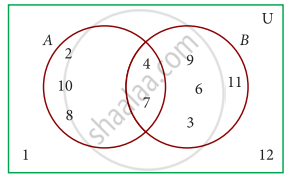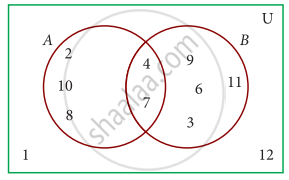Advertisements
Advertisements
Question
Find the symmetric difference between the following sets
P = {2, 3, 5, 7, 11} and Q = {1, 3, 5, 11}
Solution
P = {2, 3, 5, 7, 11}
Q = {1, 3, 5, 11}
P – Q = {2, 3, 5, 7, 11} – {1, 3, 5, 11}
= {2, 7}
Q – P = {1, 3, 5, 11} – {2, 3, 5, 7, 11}
= {1}
P ∆ Q = (P – Q) ∪ (Q – P)
= {2, 7} ∪ {1}
= {1, 2, 7}
APPEARS IN
RELATED QUESTIONS
If A = {6, 7, 8, 9}, B = {4, 6, 8,10} and C = {x : x ∈ N : 2 < x ≤ 7}; Find: B - (A - C).
If A = {6, 7, 8, 9}, B = {4, 6, 8,10} and C = {x : x ∈ N : 2 < x ≤ 7}; Find: B - B.
Using the given Venn diagram, write the element of B
Using the given Venn diagram, write the element of U
If U = {a, b, c, d, e, f, g, h}, A = {b, d, f, h} and B = {a, d, e, h}, find the following set
A’ ∩ B’
If U = {a, b, c, d, e, f, g, h}, A = {b, d, f, h} and B = {a, d, e, h}, find the following set
(A ∩ B)’
Let A and B be two overlapping set and the universal set U. Draw appropriate Venn diagram for the following
(B – A)’
Let A and B be two overlapping set and the universal set U. Draw appropriate Venn diagram for the following
What do you observe from (A ∩ B)′ and A′ ∪ B′?
If U = {x | x ∈ N, x < 10} and A = {x | x ∈ N, 2 ≤ x < 6} then (A’)’ is
If n(A) = 10 and n(B) = 15, then the minimum and maximum number of elements in A ∩ B is
